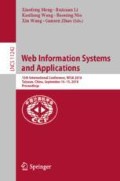Abstract
The influential users in social networks contain huge commercial value and social value, and have always been concerned by researchers. For the existing research work, there is a disadvantages in the influence of user node attributes and interest topic between users on the contribution of user influence, ignoring the oldness of the relationship between users. The paper analyzed the user topic similarity from the user’s interest similarity and tag similarity, divided the entire time interval of the user interaction relationship into a time window, and selects the four status attributes of the user’s fans number, followers number, original blog number, and number of levels. The influence of user status attribute value and user topic similarity on the contribution degree of three kinds of behavior influence on users’ forwarding, comment and mention was analyzed, and the influence of users was calculated, and a user influence evaluation method based on topic and node attributes was proposed for Weibo users. Experimenting by crawling the real dataset of Sina Weibo, compared with the typical influence analysis methods WBRank, TwitterRank, and TURank, this method was superior to the other three algorithms in terms of accuracy and recall rate.
Access this chapter
Tax calculation will be finalised at checkout
Purchases are for personal use only
References
Weng, J., Lim, E.P., Jiang, J., et al.: TwitterRank: finding topic-sensitive influential twitterers. In: WSDM, pp. 261–270 (2010)
Shipilov, A., Labianca, G., Kalnysh, V., et al.: Network-building behavioral tendencies, range, and promotion speed. Soc. Netw. 39(1), 71–83 (2014)
Li, Q., Zhou, T., Lü, L., et al.: Identifying influential spreaders by weighted LeaderRank. Physica A 404(24), 47–55 (2013)
Hong, R., He, C., Ge, Y., et al.: User vitality ranking and prediction in social networking services: a dynamic network perspective. IEEE Trans. Knowl. Data Eng. PP(99), 1 (2017)
Zhu, Z., Su, J., Kong, L.: Measuring influence in online social network based on the user-content bipartite graph. Comput. Hum. Behav. 52, 184–189 (2015)
Blei, D.M., Ng, A.Y., Jordan, M.I.: Latent dirichlet allocation. J. Mach. Learn. Res. Arch. 3, 993–1022 (2003)
Zha, C., Lyu, Y., Yin, H., et al.: UCPR: user classification and influence analysis in social network. In: IEEE International Conference on Distributed Computing Systems Workshops, pp. 311–315. IEEE (2017)
Shipilov, A., Labianca, G., Kalnysh, V., et al.: Network-building behavioral tendencies, range, and promotion speed. Soc. Netw. 39(1), 71–83 (2014)
Page, L.: The PageRank citation ranking: bringing order to the web. Stanf. Digit. Librar. Work. Pap. 9(1), 1–14 (1999)
Gleich, D.F.: PageRank beyond the Web. Comput. Sci. 57(3), 321–363 (2014)
Sun, J., Tang, J.: A Survey of Models and Algorithms for Social Influence Analysis. Social Network Data Analytics, pp. 177–214. Springer, New York (2011). https://doi.org/10.1007/978-1-4419-8462-3_7
Hu, M., Gao, H., Zhou, J., et al.: A method for measuring social influence of Micro-blog based on user operations. In: Information Technology and Applications (2017)
Yamaguchi, Y., Takahashi, T., Amagasa, T., et al.: TURank: Twitter user ranking based on user-tweet graph analysis. In: Web Information Systems Engineering—WISE 2010, pp. 240–253. DBLP (2010)
Zhaoyun, D., Yan, J., Bin, Z., et al.: Mining topical influencers based on the multi-relational network in micro-blogging sites. Chin. Commun. 10(1), 93–104 (2013)
Author information
Authors and Affiliations
Corresponding author
Editor information
Editors and Affiliations
Rights and permissions
Copyright information
© 2018 Springer Nature Switzerland AG
About this paper
Cite this paper
Liu, W., Zhang, M., Niu, G., Liu, Y. (2018). Weibo User Influence Evaluation Method Based on Topic and Node Attributes. In: Meng, X., Li, R., Wang, K., Niu, B., Wang, X., Zhao, G. (eds) Web Information Systems and Applications. WISA 2018. Lecture Notes in Computer Science(), vol 11242. Springer, Cham. https://doi.org/10.1007/978-3-030-02934-0_35
Download citation
DOI: https://doi.org/10.1007/978-3-030-02934-0_35
Published:
Publisher Name: Springer, Cham
Print ISBN: 978-3-030-02933-3
Online ISBN: 978-3-030-02934-0
eBook Packages: Computer ScienceComputer Science (R0)

